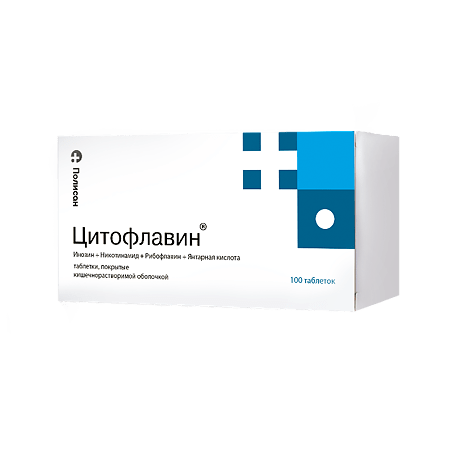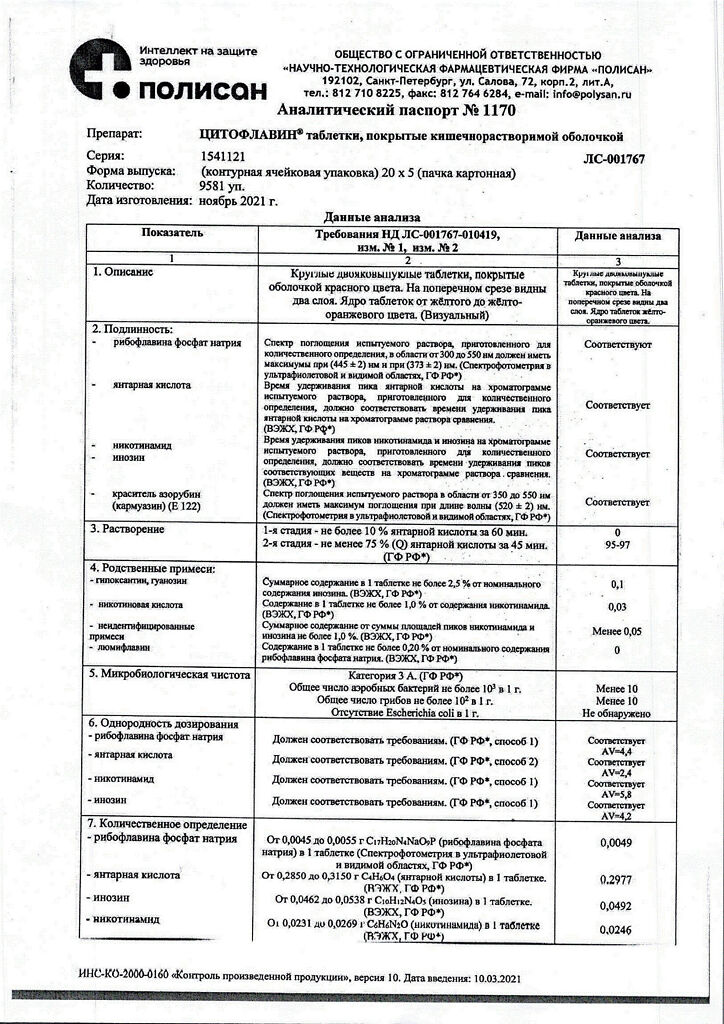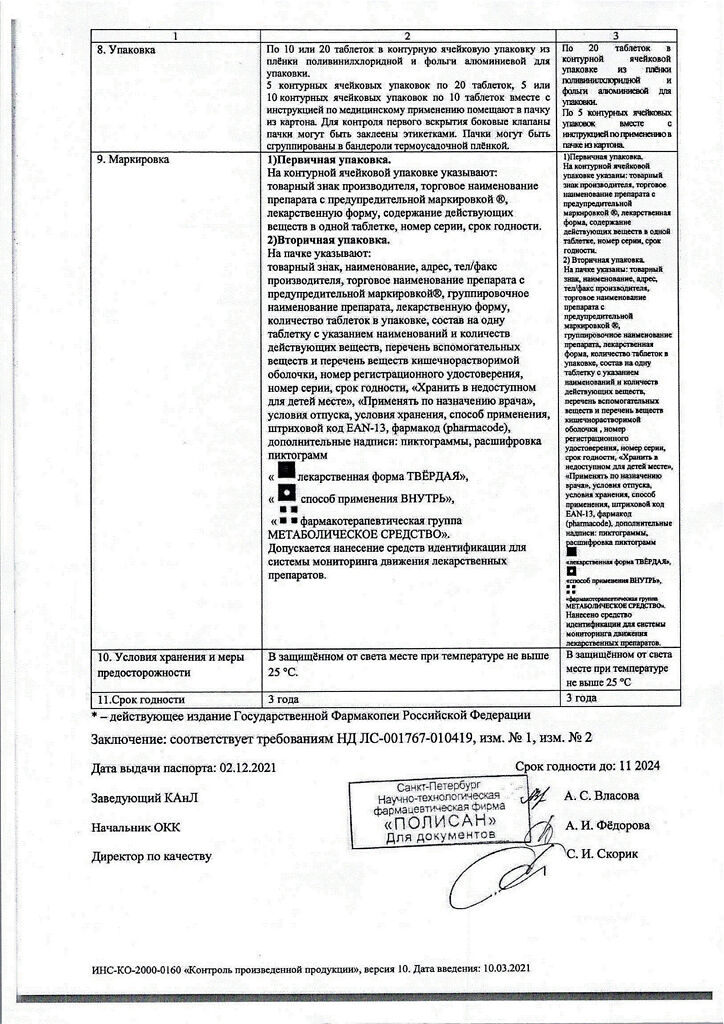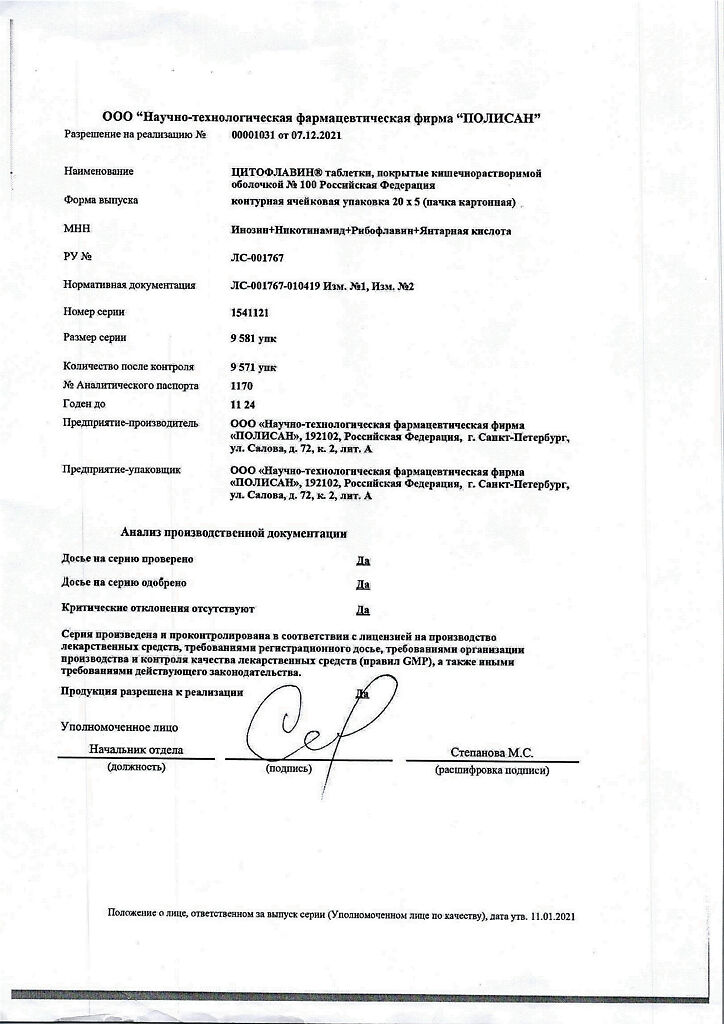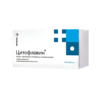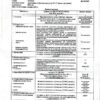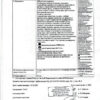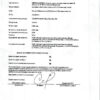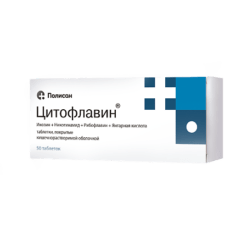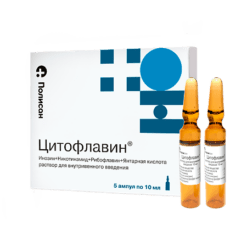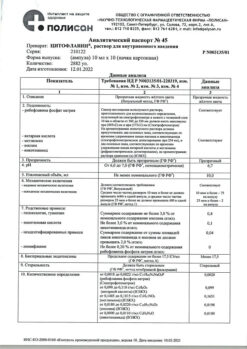No products in the cart.
Cytoflavin, 100 pcs
€25.27 €23.26
Description
Pharmacodynamics
Pharmacological effects are caused by the complex action of the constituent components of CITOFLAVIN®.
CITOFLAVIN® promotes activation of aerobic metabolism of cells resulting in increase of glucose utilization, promotes increased level of beta-oxidation of fatty acids and resynthesis of γ-aminobutyric acid in neurons.
CITOFLAVIN® increases resistance of nerve and glial cell membranes to ischemia, which is manifested by a decrease in the concentration of neuro-specific proteins that characterize the level of destruction of the main structural components of nervous tissue.
CITOFLAVIN® improves coronary and cerebral blood flow, activates metabolic processes in the central nervous system, restores disturbed consciousness, facilitates regress of neurological symptoms and improves brain cognitive functions. It has a fast awakening effect in post-arrest depression of consciousness.
When administering CITOFLAVIN® within the first 12 hours of the onset of stroke a favorable course of ischemic and necrotic processes in the affected area (decrease of the focus), recovery of neurological status and decrease of disability level in the long-term period are observed.
Pharmacokinetics
Cytoflavin has high bioavailability.
Amber acid when taken orally penetrates from the gastrointestinal tract into the blood and tissues, participating in reactions of energy metabolism, and is completely broken down to the end products of metabolism (carbon dioxide and water) in 30 minutes.
Inosine is well absorbed from the gastrointestinal tract. Time of reaching maximum concentration in blood is 5 hours, average time of retention in blood is 5.5 hours, equilibrium volume of distribution is about 20 liters. Inosine is metabolized in the liver to form inosine monophosphate with its subsequent oxidation to uric acid. Insignificant amount is excreted by the kidneys.
Nicotinamide is rapidly distributed in all tissues (equilibrium volume of distribution is about 500 liters). Time of reaching maximum concentration in blood is 2 hours, average time of retention in blood is 4.5 hours. Nicotinamide penetrates through the placenta and into the breast milk, is metabolized in the liver to form N-methylnicotinamide, excreted by the kidneys.
Riboflavin is rapidly absorbed from the gastrointestinal tract, distributed unevenly (the greatest amount in the myocardium, liver and kidneys), is transformed into flavinadenine mononucleotide (FMN) and flavinadenine dinucleotide (FAD) in mitochondria. Passes through the placenta and into breast milk; excreted by the kidneys, mainly as metabolites.
Indications
Indications
In adults in complex therapy:
1. Acute cerebrovascular accident.
2. Consequences of cerebrovascular diseases (consequences of cerebral infarction, cerebral atherosclerosis).
3. Toxic and hypoxic encephalopathy in acute and chronic poisoning, endotoxicosis, post-anesthesia depression of consciousness, as well as for the prevention and treatment of hypoxic encephalopathy during cardiac surgery using artificial circulation.
In children (including premature infants with a gestation period of 28-36 weeks) in complex therapy in the neonatal period:
1. For cerebral ischemia.
Pharmacological effect
Pharmacological effect
Pharmacodynamics
Pharmacological effects are due to the complex effect of the components included in the drug CYTOFLAVIN®.
CYTOFLAVIN® promotes activation of aerobic cell metabolism, which leads to an increase in the level of glucose utilization, promotes an increased level of beta-oxidation of fatty acids and the resynthesis of γ-aminobutyric acid in neurons.
CYTOFLAVIN® increases the resistance of the membranes of nerve and glial cells to the effects of ischemia, which is expressed in a decrease in the concentration of neurospecific proteins that characterize the level of destruction of the main structural components of nervous tissue.
CYTOFLAVIN® improves coronary and cerebral blood flow, activates metabolic processes in the central nervous system, restores impaired consciousness, promotes regression of neurological symptoms and improves cognitive functions of the brain. It has a quick awakening effect during post-anesthesia depression of consciousness.
When using the drug CYTOFLAVIN® in the first 12 hours from the onset of stroke, a favorable course of ischemic and necrotic processes in the affected area (reduction of the lesion), restoration of neurological status and a decrease in the level of disability in the long-term period are observed.
Pharmacokinetics
Cytoflavin has high bioavailability.
When taken orally, succinic acid penetrates from the gastrointestinal tract into the blood and tissues, participating in energy metabolism reactions, and completely decomposes to the final metabolic products (carbon dioxide and water) after 30 minutes.
Inosine is well absorbed from the gastrointestinal tract. The time to reach maximum concentration in the blood is 5 hours, the average retention time in the blood is 5.5 hours, the equilibrium volume of distribution is about 20 liters. Inosine is metabolized in the liver to form inosine monophosphate, followed by its oxidation to uric acid. A small amount is excreted by the kidneys.
Nicotinamide is rapidly distributed in all tissues (equilibrium volume of distribution is about 500 liters). The time to reach maximum concentration in the blood is 2 hours, the average retention time in the blood is 4.5 hours. Nicotinamide crosses the placenta and into breast milk; metabolized in the liver to form N-methylnicotinamide, excreted by the kidneys.
Riboflavin is rapidly absorbed from the gastrointestinal tract, distributed unevenly (the largest amount in the myocardium, liver, kidneys), and is transformed into flavin adenine mononucleotide (FMN) and flavin adenine dinucleotide (FAD) in mitochondria. Penetrates through the placenta and into breast milk; excreted by the kidneys, mainly in the form of metabolites.
Special instructions
Special instructions
In case of hypertension, dose adjustment of antihypertensive drugs may be required.
In patients with diabetes mellitus, treatment should be carried out under the control of blood glucose concentration.
Possible intense yellow coloration of urine.
CYTOFLAVIN does not affect: the ability to drive vehicles, work with moving mechanisms, the work of dispatchers and operators.
Active ingredient
Active ingredient
Inosine, Nicotinamide, Riboflavin, Succinic acid
Composition
Composition
1 tablet contains:
active substances:
succinic acid – 0.3 g;
riboxin (inosine) – 0.05 g;
nicotinamide – 0.025 g;
riboflavin mononucleotide (riboflavin) – 0.005 g;
excipients:
medium molecular weight polyvinylpyrrolidone (povidone),
calcium stearate,
copolymer of methacrylic acid and ethyl acrylate,
1,2-propylene glycol,
acid red 2C,
Tropeolin O.
Contraindications
Contraindications
Hypersensitivity, in patients on mechanical ventilation, when the partial pressure of oxygen in arterial blood decreases to less than 60 mm Hg. Art., period of breastfeeding.
With caution – nephrolithiasis, gout, hyperuricemia.
Side Effects
Side Effects
Headache, pain or discomfort in the epigastric region.
Allergic reactions in the form of skin hyperemia and itching are possible. Adverse reactions include: transient hypoglycemia, hyperuricemia, exacerbation of concomitant gout.
If any of the side effects indicated in the instructions get worse or you notice any other side effects not listed in the instructions, tell your doctor.
Interaction
Interaction
Succinic acid, inosine and nicotinamide are compatible with other drugs.
Riboflavin reduces the activity of some antibiotics (tetracyclines, erythromycin, lincomycin) and is incompatible with streptomycin.
Ethanol, tricyclic antidepressants, tubular secretion blockers reduce the absorption of riboflavin, and thyroid hormones accelerate its metabolism.
Overdose
Overdose
To date, no cases of overdose with CYTOFLAVIN have been identified.
Storage conditions
Storage conditions
In a dry place, protected from light, at a temperature not exceeding 25 °C
Shelf life
Shelf life
2 years
Manufacturer
Manufacturer
Polisan NTFF LLC, Russia
Additional information
| Shelf life | 2 years |
|---|---|
| Conditions of storage | In a dry, light-protected place at a temperature not exceeding 25 °C |
| Manufacturer | Polysan NTFF LLC, Russia |
| Medication form | enteric-soluble film-coated tablets |
| Brand | Polysan NTFF LLC |
Other forms…
Related products
Buy Cytoflavin, 100 pcs with delivery to USA, UK, Europe and over 120 other countries.

